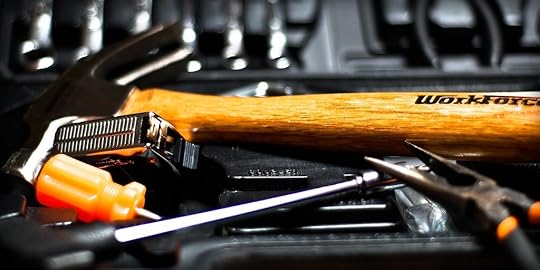How To Cure ‘Malfunction Anxiety’

Get your tools out to help fight malfunction anxiety.
How To Cure ‘Malfunction Anxiety’
If you own Things, those Things will break.
The older you get, the more Things you will own.
They start off small, but they get larger, until ultimately you own the largest Thing you will ever own – a house. Which is, of course, nothing but an expensive repository for your Things. Every room in your house is full of Things.
Things everywhere.
And when you own Things, the Things break. One minute your phone just works, the next it doesn’t. Your boiler? It heats the house, then it doesn’t. Your car? A rolling collection of stuff waiting to go wrong.
Sometimes it can feel like the Things are conspiring against you. By definition a broken Thing is never convenient. Have a huge mountain of laundry to do and no clean underwear? Uh-oh! Sorry, this appliance is refusing to comply. Add to that the worrying rattle in the car, and the ever-slowing response time of your laptop, and it can be a real pain in the arse.
It’s what I call ‘Malfunction Anxiety’.
It’s the vague sense of being unsettled, knowing that something once reliable and often invisible is now defying you. It’s complicating your day. It’s costing you money. Anxiety, in any form, is something you want to eliminate from your life whenever possible.
There’s a cure for Malfunction Anxiety – fixing Things.
When Things break, they can often be fixed, and fixed by you. Doing it yourself saves you money as well as teaching you a skill. It might not be something ultra technical or very specialised, but it’s something you never knew before, but now you do. I’d suggest you stay away from gas and electrical equipment unless you know what you’re doing, but most other things can be fixed with a bit of research, time, the right tools, and sometimes a small monetary outlay.
Not long ago our washing machine started making an unhealthy grinding noise towards the end of its cycle. I grimaced and backed away slowly, hoping it would magically fix itself if I left it alone. Of course, this didn’t happen and later I found it dormant and still full of water. But helpfully it was displaying an error message. The manual was next to useless, simply pointing me to their engineer call centre. So of course I did the next obvious thing – I went online. The error message was apparently related to the filter pump, and several forums and YouTube videos suggested it was an easy fix.
And so it was. Remove the kick-plate at the front of the unit, drain the water from the pump outlet, and remove any blockages. In this case it was a bra wire. I probably spent longer reading forum posts about the problem than I did fixing it. As soon as it was all back together, I was doing another laundry load.
So in this instance I went from ‘malfunction anxiety’ to smug self-satisfaction within an hour. How much would an engineer have cost? Hard to say, but I’d assume it would have been between £50 – £100. But the real saving, or earning, is the fact that I did it myself. I now know how to fix this problem. I am no longer afraid of a Thing. I no longer have ‘malfunction anxiety’.
This is the way to look at it when Things break. They’re setting you a challenge, and thanks to the internet you can excel at completing this challenge. I’m always amazed when people complain about something not working or behaving strangely, but haven’t bothered to Google it. If your Thing has broken, you can be sure someone else’s has too, and more importantly, they’ve moaned about it on the web and been directed toward a fix.
Your friends and colleagues can also be good allies in the war against Things.
Another case study:
The boiler in our house suddenly started vomiting water all over the place. Instead of calling a plumbing company and waiting ages for them to arrive, and then pay the subsequent bill, we phoned a friend of ours who is a plumber but lives miles away. He ran through the steps to stop the water escaping, reconnecting the blown hose, and then to re-pressurise the boiler. Not long after it was all working again. Running to a repair company would have cost time, money, and more importantly, would have denied me the knowledge I now have.
(Whilst I did point out that messing with gas and electric supplies is not recommended, I was 100% sure in the case above that this had nothing to do with the gas supply, so I was confident doing it myself)
There’s another huge benefit to fixing broken Things, and that’s waste prevention. We’ve become far too accustomed to throwing Things out when they’re broken, simply because we think they can’t be fixed, but more likely because we can’t be bothered. Easier to buy a new laptop/washing machine/lawnmower than work out what’s wrong with it in the first place. Companies love that we think this way. They make it easy for us to replace old-with-new, just so they can sell you new Things. Which will, of course, eventually break.
“Daddy fix it.”
Now that I have children, I am often faced with this scenario; I am handed a broken toy or another random household item and told ‘Daddy fix it.’ It’s a great example of the heart-breakingly simple logic that children employ - ‘I’ve encountered a problem, but don’t worry I know how to resolve it’. They hand the broken Thing over to an adult and all is solved. Often it’s not solved, and the adult has to find a way around that issue too.
Garbage Finds is one of my favourite blogs on the subject of waste, and in this case how to profit from other people’s broken Things. The blogger scours the streets in his native Montreal to look for discarded treasure, and he’s pretty damn successful too.
Here’s a list of the Things that have broken over the last few months and I’ve been able to fix myself, earning some smug self-satisfaction along the way;
Vailant Boiler – The heating boiler blew a hose and emptied its contents all over the floor. Once I’d stopped panicking about the very minor flooding I was able to shut it down, re-attach the pipes to the fitting, re-pressurise it and get it going again. Very satisfying, as no boiler = no heating or hot water.
Washing Machine – A blocked filter pump meant the whole thing ground to a halt, mid-cycle. Accessed the pump, drained the water and got it running again in less than an hour.
Vibrate function on iPhone – I noticed that this had stopped working. A quick browse of the internet suggested that a sharp tap on a hard surface should get it going again, and so it did. I like this fix, as it involves a small amount of dumb, brute force on a highly sophisticated piece of technology.
Petrol Lawnmower – This was running rough and eventually just stopped running. I went online, read a few forums and watched some videos and diagnosed the issue as old petrol and a clogged carburetor. Now it’s running great.
If it worked, then broke, and then you fixed it, you win!
The post How To Cure ‘Malfunction Anxiety’ appeared first on Sharpist.




